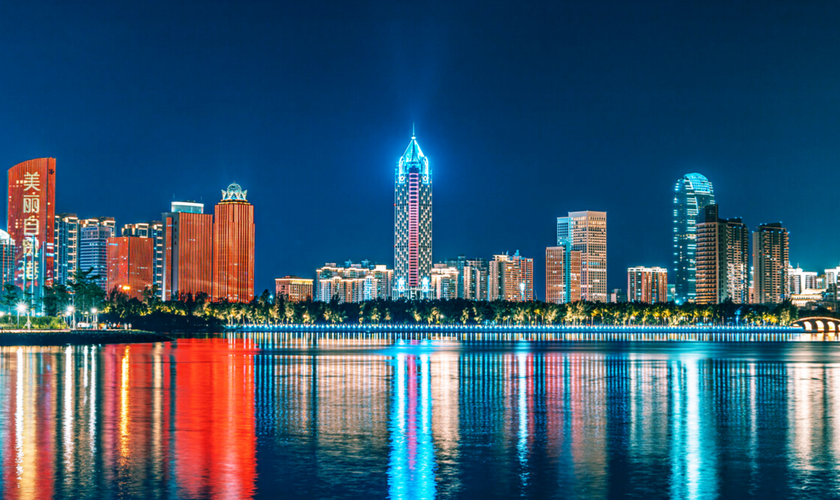Nestled on the northern tip of Hainan Island, Haikou—often dubbed the “Coconut City”—is a captivating blend of tropical charm, historical depth, and modern ambition. As the capital of Hainan Province and a core city of the China (Hainan) Free Trade Port, Haikou offers travelers a unique tapestry of experiences. Let’s dive into its urban development, storied past, must-visit attractions, and mouthwatering cuisine.
Urban Development: Bridging Tradition and Innovation
Haikou’s skyline tells a story of rapid growth intertwined with ecological mindfulness. The city’s 2021–2035 Master Plan emphasizes sustainable development, aiming to transform it into an international transport hub and a model of “smart city” infrastructure. Key projects like the Jiangdong New Area showcase futuristic urban design, while the Haikou Bay Coastal Project revitalized 19 kilometers of waterfront, integrating green spaces, cycling paths, and cultural venues like the Cloudscape Library. This architectural marvel, resembling a floating cloud, has become a symbol of Haikou’s creative spirit.
The city also balances modernity with heritage preservation. The merger with Qiongshan in 2002 expanded its administrative reach, allowing for coordinated development that respects historical landmarks.
History: A Portal to the Past
Haikou’s history stretches back over 2,000 years. Once a frontier outpost during the Han Dynasty, it flourished as a maritime hub on the ancient Maritime Silk Road. By the Song Dynasty, it was known as “Haikou Pu” (海口浦), a bustling port where merchants traded spices, ceramics, and tropical goods.
The Qilou (Arcade) Old Street, with its南洋-style buildings, stands as a testament to Haikou’s role in the 19th-century overseas Chinese diaspora. These elegantly weathered structures, adorned with intricate carvings, now house cafes, galleries, and boutiques. Meanwhile, the Wugong Temple and Hai Rui Tomb pay homage to exiled scholars and revered officials who shaped Hainan’s cultural identity.
Must-Visit Attractions: Nature, Culture, and Adventure
- Volcanic Clusters Geopark: Explore ancient lava tunnels and lush craters in this UNESCO-listed park, a reminder of Haikou’s fiery geological origins.
- Dongzhai Port Mangrove Reserve: Kayak through serene waterways flanked by mangrove forests, home to migratory birds and rare ecosystems.
- Holiday Beach & Xixiu Beach: Soak up the sun or try windsurfing at these popular coastal spots.
- Haikou Movie Town: Step into film sets replicating 1940s-era streetscapes, a nod to China’s cinematic history.
- Qiongtai Academy: Founded in the Qing Dynasty, this scholarly retreat offers insights into Hainan’s educational heritage.
For nightlife, the Haikou Bay Bar Street buzzes with live music and waterfront views.
Culinary Delights: A Feast for the Senses
Haikou’s cuisine mirrors its multicultural roots, blending Hainanese, Cantonese, and Southeast Asian influences:
- Hainanese Chicken Rice: Tender poached chicken paired with fragrant rice cooked in chicken broth.
- Wenchang Seafood: Fresh catches like grilled oysters and prawn congee dominate menus in fishing villages like Qukou.
- Shishan Volcanic Goat: Slow-cooked goat meat, celebrated for its tenderness and served in hotpot or braised styles.
- Cooling Desserts: Beat the heat with Qingbuliang (coconut milk-based dessert) or Yemaodan (sweet potato balls in ginger syrup).
Don’t miss the Dadongmen Night Market, where stalls serve everything from spicy snail noodles to crispy coconut pancakes.
Conclusion: Haikou’s Allure
From its ancient roots as a trading port to its current role as a gateway to tropical China, Haikou captivates with its duality—a city where history whispers through colonial arcades and innovation soars in glass-clad towers. Whether you’re tracing the footsteps of scholars, savoring a coconut under palm trees, or cycling along sunset-kissed beaches, Haikou invites you to write your own chapter in its ever-unfolding story.
Pack your bags—the “Coconut City” awaits! 🌴✨
: Historical and cultural highlights.
: Coastal attractions and ecological reserves.
: Nightlife and modern urban spaces.
: Urban planning and development strategies.
: Infrastructure and architectural landmarks.
: Historical mergers and heritage preservation.
: Maritime and trade history.
: Architectural and cultural fusion.
: Beach activities and tourism.
: Mangrove ecosystems and outdoor adventures.
: Geological and natural wonders.
: Street food and traditional desserts.
: Signature dishes and culinary hotspots.
